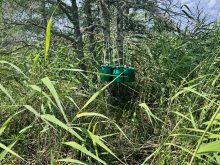Several hundred residents in the village of Roche Percee, the Rural Municipality of Estevan and the cities of Weyburn and Estevan were evacuated last weekend as water rushed through the Souris River system.
Government officials said some of the evacuees had registered at shelters set up in the two cities, but most found accommodation with family and friends.
Dale Hjertaas, executive director of policy and communications at Saskatchewan Watershed Authority, said June 20 that more than 100 millimetres of rain during the weekend produced high flows and filled reservoirs that were still emptying from earlier rain.
Read Also

Government, industry seek canola tariff resolution
Governments and industry continue to discuss how best to deal with Chinese tariffs on Canadian agricultural products, particularly canola.
Water levels were expected to climb another 50 centimetres by June 21 through the Estevan and Roche Percee areas.
The renewed flooding resulted when more water was released from the Boundary and Raffety reservoirs. Area residents complained that the reservoirs should have been used to mitigate flooding, but Hjertaas said little could be done after several earlier rainfalls filled the reservoir.
“The bottom line is … just an awful lot of rain fell and an awful lot of water is coming and the capacity of the reservoir to hold it back is limited,” he said.
“Therefore, most of it needs to be passed on through at this point.”
The water is rushing out of the two reservoirs at a combined rate of 555 cubic metres per second, or enough to fill an Olympic-sized swimming pool every five seconds.
“Flows through Estevan will probably increase somewhat further,” Hjertaas said. “We’re monitoring that through the day and will do what’s necessary.”
Total rainfall at Estevan since May 1 was 287 mm as of June 20. The normal annual total is 333 mm.
Water levels downstream from Rafferty and Boundary dams in southeastern Saskatchewan are expected to remain high this week.
It is the wettest May-June since record keeping began in 1945.
Weyburn received 112 mm over the weekend and much of the south-central and southeast received as much as 60 mm.
Saskatchewan premier Brad Wall toured the region June 20.
Meanwhile, officials continue to watch other river systems.
Hjertaas said the North Saskatchewan River peaked at 2,000 cubic metres per second in Edmonton, which was expected to hit Prince Albert, Sask., by June 24 or 25, causing water levels to rise 2.5 metres.
Although inflow to Lake Diefenbaker has eased, the releases from that reservoir will keep the South Saskatchewan River flowing at about 1,600 cubic metres per second through Saskatoon. The flows from both rivers will meet and produce flow from Tobin Lake at 3,000 to 3,500 cubic metres per second.
The water will eventually reach Cumberland House, which Hjertaas said has had lots of time to prepare.
Flows on the Qu’Appelle River and lakes systems have also increased but will result mainly in a slower recession rather than significantly higher levels.
The watershed authority has also increased the outflow through Alameda Dam from 27 to 50 cubic metres per second.
Hjertaas said all the southeast water is heading to Minot, North Dakota, where there will be a significant flood.
In Alberta, the central part of the province west of Edmonton between Slave Lake and Sundre and east toward Camrose received 15 to 35 mm of rain on the weekend.
Up to 40 mm fell in central regions June 19 and more is expected due to daytime heating that increases thundershower risk.
As of June 20, a flood watch remained in effect for the Little Red Deer River, and high stream flow advisories were in place for many streams in the Red Deer, North Saskatchewan, Athabasca and Peace River basins.

















